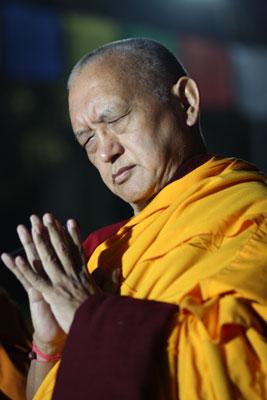My teacher Geshe Sopa Rinpoche told the Sangha, the monks and nuns, that our morality can degenerate so easily, like rocks falling down a mountain. He advised [maintaining our morality] is like pushing a heavy rock up a mountain; we have to push a little bit and then a bit more, then gradually, little by little, we can get it to the top! We have to try like that. It is not easy because delusions are so powerful. That is why so far, from beginningless rebirths up to now, we haven’t become totally liberated from the suffering of samsara.
But if we put effort in like Guru Shakyamuni Buddha, we can gradually change the mind into bodhicitta from self-cherishing thought. Guru Shakyamuni Buddha put effort and collected merit for three countless great eons, practicing the six paramitas. He worked so hard for us sentient beings. For three countless great eons he sacrificed his life. Even when he was born as a king, he gave up his life, his family, his children, his wealth. He gave it all up for us, making charity to other beings, even making charity of his family members and wealth to others, not just during one life but in many lifetimes. He made charity to many sentient beings in many millions of lifetimes, giving even his whole body to ants and tigers. At Namo Buddha in Nepal, the Buddha gave his holy body as charity to the tiger. It is still a holy place we can go to see.
He sacrificed his life like this for three countless great eons for us sentient beings, for every one of us here. The Buddha worked so hard to complete the two types of merit—the merit of fortune and the merit of wisdom—and achieved the two kayas, to be able to reveal the Dharma, the path, to us sentient beings without any mistake. With perfect compassion and the power of omniscience, he revealed to us the unmistaken path to liberation and enlightenment. Even though we cannot see the Buddha, we can see his teachings. We can study his teachings that he himself experienced, that he himself went through and proved they worked.
As I have mentioned at other times, there are numberless sentient beings who have achieved enlightenment in different countries. We can read their life stories that tell how they practiced, how they achieved realizations, stories like Milarepa’s life story, like Lama Tsongkhapa’s. There are many life stories from the four Tibetan Mahayana traditions, stories of the many great pandits who achieved realizations.
I must bring my talk back to the original topic!
Already numberless sentient beings, not only Guru Shakyamuni Buddha, have become enlightened. They were the same as us; they all had delusions, difficulties, problems, but they continuously put effort into developing their mind in the path from life to life, just as the Buddha had for eons.
We should plan in the same way, instead of thinking that by doing some meditation we will achieve enlightenment within few years. Or after a one-month’s meditation course we will become enlightened! At the end of his teachings to Tibetans, His Holiness the Dalai Lama specifically often advises Western students that we shouldn’t be shortsighted, thinking that we will achieve enlightenment after practicing for a very short time. We shouldn’t think like that; we must plan for many hundreds of lifetimes. I don’t remember what he said word-for-word, but it is something like if we plan to practice Dharma for a long time, if we put effort in for a long time, then it is possible to achieve enlightenment in a short time, without taking much time. But if we don’t have a plan like that, if we are shortsighted, thinking it is very easy and quick to have realizations and achieve enlightenment, that becomes an obstacle. When we can’t, we get disappointed and we give up. This is more or less what His Holiness said.
Therefore, as Geshe Sopa explained, if the rock is heavy but we push it up little by little, by continuing every day, after some time we will be able to reach the top of the hill. Then, when we achieve the exalted arya path, by achieving the path of meditation, we are able to remove even the seed of delusion, making it impossible for karma and delusions to arise. After that, there will be no more rebirth, no more death, no more suffering forever.
It needs continual effort. Because our mind is habituated to anger, attachment, delusions, being under their control from beginningless rebirth, it is not easy. We have to understand why it is not easy to practice patience. It is even difficult to remember when a delusion is about to arise. Even though we might know every Buddhist text very well by heart and all the meditation techniques, when we encounter a situation that causes a delusion to arise, it is still hard to remember the meditation technique at that time. Totally overwhelmed by delusion, besides applying the technique, we can’t even remember it. It’s not easy but we have to put effort. Then the mind becomes more conscientious, more thoughtful; then we are able to remember more and more of the meditation techniques and are able to apply them more and more. Even though we do miss sometimes, we are also able to practice sometimes, and if we continue we will be able to practice more and more. We won’t miss so much, we will be able to practice even more, and then we will win over the delusions more and more.





























